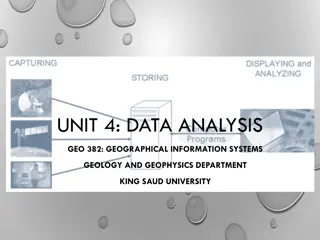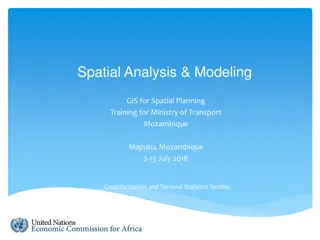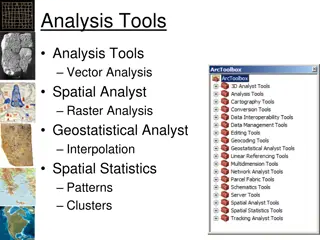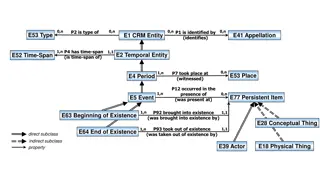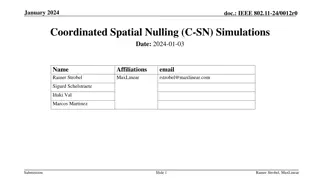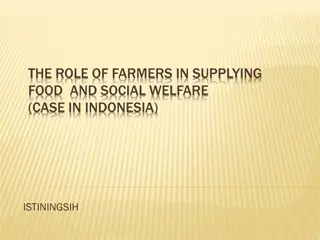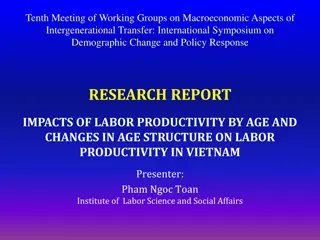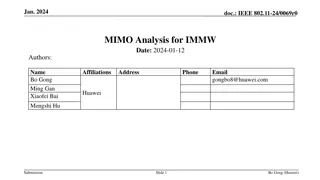Impact of Transmigration Program on Spatial Productivity in Indonesia
The study examines the economic impact of Indonesia's Transmigration Program, which relocated two million voluntary migrants from rural areas of inner islands to agricultural settlements in outer islands. Using a natural experiment design, it shows how skill transferability influences agricultural productivity and how migrants adapt to agroclimatic changes. The research sheds light on the relationship between migration and regional productivity differences, crucial in the context of labor allocation debates and population displacement risks from natural disasters and climate change.
Download Presentation

Please find below an Image/Link to download the presentation.
The content on the website is provided AS IS for your information and personal use only. It may not be sold, licensed, or shared on other websites without obtaining consent from the author. Download presentation by click this link. If you encounter any issues during the download, it is possible that the publisher has removed the file from their server.
E N D
Presentation Transcript
Research in Development Economics: Natural Experiments Dr. Kamiljon T. Akramov IFPRI, Washington, DC, USA Training Course on Applied Econometric Analysis September 13-23, 2016, WIUT, Tashkent, Uzbekistan
Skill Transferability, Migration, and Development: Evidence from Population Resettlement in Indonesia (Bazzi et al., AER, 2016) The paper uses a natural experiment design to examine the role of location-specific human capital and skill transferability in shaping the spatial distribution of productivity It uses plausibly exogenous variation from a large-scale rural-to-rural resettlement program in Indonesia to identify the causal impact of skill transferability on agricultural productivity. Villages assigned migrants from regions with more similar agroclimatic endowments exhibit higher rice productivity intensity one to two decades later. The paper also finds some evidence of migrants adaptation to agroclimatic change
Policy question Relationship between migration and regional productivity differences This is important for several reasons Recent debate on whether labor is misallocated across space and whether migration can equalize regional productivity differences (Munshi and Rosenzweig 2016; Young 2013) Growing risks of population displacement from natural disasters, conflict, or climate change, force various governments to plan for resettlement (see IPCC 2014; de Sherbinin et al. 2011) Extreme weather events are expected to uproot over 60 million people in South Asia alone (Stern 2007) Understanding how abrupt changes in agroclimatic conditions affect productivity is important in light of climate change
Specific research question The paper provides a causal evidence on the economic impact of Transmigration program in shaping spatial productivity differences in Indonesia The Transmigration Program relocated two million voluntary migrants from rural areas of overpopulated inner islands to newly created agricultural settlements in relatively unsettled outer islands The program targeted entire families for resettlement Participating couples had to be legally married, with the household head between 20 and 40 years of age Most participants were poor, landless agricultural laborers, and less educated Transmigrants were given free transport to new settlements and free housing They received a two hectare plot of agricultural land allocated by lottery upon arrival, and provisions for the first few growing seasons, including seeds, tools, and food
Assignment of the Transmigrants Time, information, and institutional constraints prevented policymakers from systematically assigning transmigrants to destination villages Sharp changes in world oil prices strongly affected government revenue, leading to a rapid expansion and sudden contraction of the program Government planners had neither the interest nor the resources to match transmigrants on the basis of agroclimatic conditions Coincidental timing of transmigrants arrival to the transit camps and the opening of new settlements in the Outer Islands played a key role in determining where transmigrants were placed Program participants could not choose their destination in the Outer Islands These factors resulted in significant transmigrant diversity at new settlements The median Transmigration village has migrants from 46 sending districts
Empirical strategy Study investigates the relationship between productivity and agroclimatic similarity using this key regression specification ??= ??+ ?? where ??is a village level productivity , a key parameter of interest, measures the semi-elasticity of aggregate productivity with respect to average agroclimatic similarity for the village ??, the key sources of exogenous variation at village-level, includes (i) variation in the absolute differences between predetermined agroclimatic characteristics, and (ii) variation in the share of Java/Bali migrants in destination village j who are from origin district i ?? ? + ?? maps observable agroclimatic characteristics of location j into productivity
Identification Endogenous location, crop, and occupation choices could undermine the comparison of rice productivity in high and low similarity villages To estimate skill transferability across locations in the agricultural context, one needs (i) Randomly assign farmers from many origins to many destinations, and (ii) Minimize selection biases due to crop and occupational choices The exogenous relocation process assures (i) Selection bias (ii) is minimized by The fact that previously landless transmigrants embarked on the program with the goal of farming, and their newly acquired land tied the first generation movers to farming Rice was grown by virtually all transmigrants prior to departure, and its pervasiveness across program villages makes it a natural focal crop
Identification (cont.) Additional checks show that Agroclimatic similarity is uncorrelated with pre-program correlates of productivity, which rules out first-order concerns about unobserved natural advantages individuals from origin districts in the bottom quintile of potential rice productivity in inner island have significantly higher individual agroclimatic similarity than those coming from origin districts in the top quintile of potential productivity These evidences suggests that agroclimatic similarity is balanced across Transmigration villages and is not proxying for unobservable natural advantages prevailing in inner islands
Data Study focuses on 814 villages that were created under the Transmigration program The study uses the following data sources Digitized census of program settlements, produced by the Ministry of Transmigration to identify transmigrant villages Harmonized World Soil Database (HWSD) to measure agroclimatic characteristics including elevation, slope, ruggedness, altitude, distance to rivers and the sea coast, rainfall, temperature, and soil texture, drainage, sodicity, acidity, and carbon content Temperature and precipitation data from UDel The 2000 population census to identify each individual s district of birth and his or her current village of residence The 2002 round of triennial administrative census known as Podes (or Village Potential) to measure agricultural productivity Various auxiliary datasets
Findings The study finds that villages that were assigned a higher share of migrants from agroclimatically similar origins in inner island exhibit greater rice productivity compared to villages that were assigned migrants from less similar origins It finds large effects for rice and moderate effects for other food crops Findings suggest that some of the observed spatial productivity gaps may be explained by barriers to transferring skills and ultimately adjusting to new economic environments The results have important implications for the design of future resettlement programs Evidence from a simulation exercise suggests sizable aggregate rice productivity gains from optimally allocating migrants on the basis of agroclimatic similarity Paper finds the largest barriers to transferability for soil-specific skills and for villages in the bottom tercile of agroclimatic similarity It also finds that both social capital within resettlement areas and interacting with natives are important adaptation mechanisms that should be considered when resettling people to new growing environments









